Noongar Plant Species list
Kaya (hello)! – how many plant species names do you know of the Aboriginal language group from your part of Australia?
Some beautiful native plants are found in Australia, with many of them being used by Indigenous Noongar people as bushtucker foods or for cultural or medicinal purposes.
This reference material describes native Australian plant species by their common name, botanical name and the Noongar name, with the aim to help our community connect with nature and history.
Consider planting some of these species in your garden for local wildlife and biodiversity!
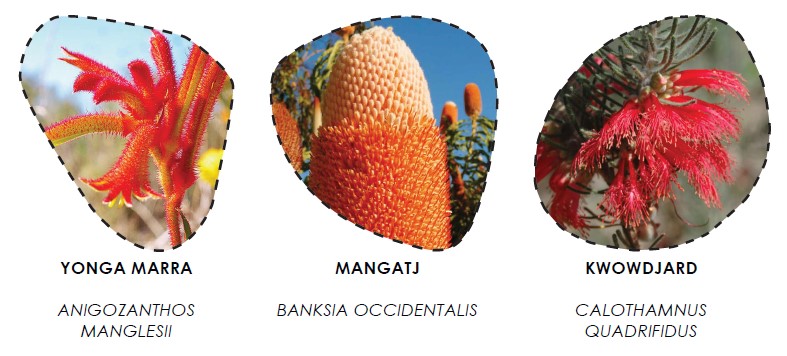
Kangaroo paws have attractive and unusual flowers as well as tuberous roots which contain significant levels of stored starch. In a similar way to orchids and some lily species, the roots of kangaroo paws are eaten by Noongar people.
Prior to large-scale land clearing, it is likely that kangaroo paws were far more abundant than they are today. Root tubers formed an important part of the traditional Noongar diet, and it is possible that the roots of kangaroo paws were gathered in large quantities.
Banksia flowers produce an abundance of honey-like nectar, which is why the early colonists called this plant the Honeysuckle. Noongar people drink the honey straight out of the flower cone, or soak the flower in water to produce a sweet drink. Some banksias, such as the Piara and the Mungite are used by Noongar people as torches. When alight, the dried banksia flower cone smoulders like a torch, these were used by local Noongars to transport fire from one campsite to the next. Noongar people also kept the lighted cones under their cloaks to keep themselves warm in cold weather.

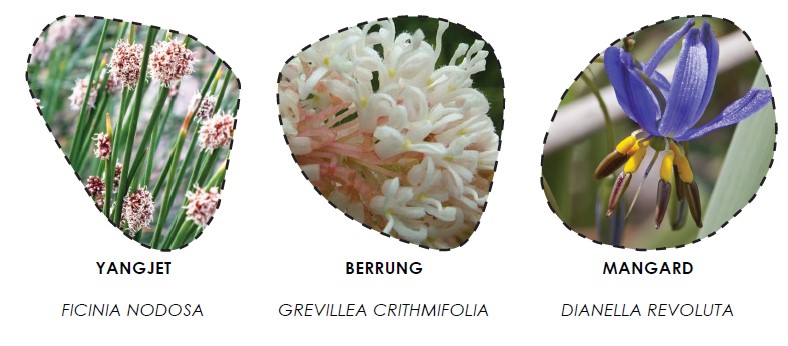
Similar to other flowering plants, the blossoms of the Bottlebrush are useful to Noongar people as a source of honey.
The Yanchet was said to be eaten raw by Noongar people in vast quantities, although it is not known exactly which species this refers to. Many species of rushes and sedges are used by Noongar people to locate water. The leaves of rushes and sedges are also used in weaving. The leaves are woven to create nets which are used as seines to catch djildjit (fish) and yakan (turtle). Rushes and sedges can also be woven to create baskets and mats and the leaves of many species are used as string.
The Grevillea Genus is a diverse group of over 350 plants which range from low-lying shrubs to tall trees. The nectar from Berrung plants is an important source of honey. Similar to other flowering plants, the nectar from grevilleas can be sucked directly from the flowers or soaked in water to produce a sweet drink. Sometimes the drink is allowed to ferment to produce Gep, an intoxicating liquor.
Lilies are very important to Noongar people due to their nourishing root tubers. Roots were an essential part of the diet of traditional Noongar people and various species of lilies produce an abundance of edible roots. Some lilies also produce an edible fruit or seed.

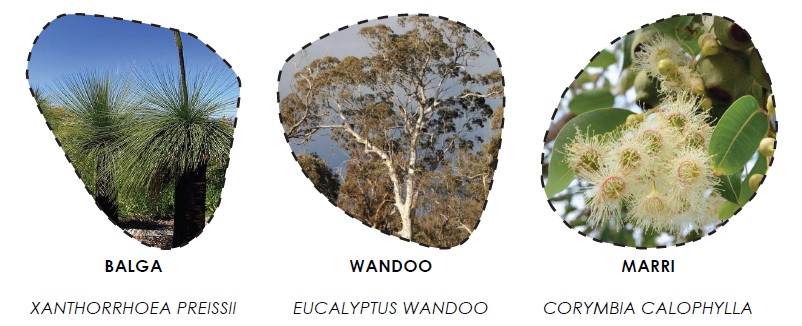
The Balga is an extremely important plant for Noongar people and many parts of this plant can be used. The long, thin fronds of the Grass Tree, called mindarie, can be used to cover the roof of the mia-mia (shelter). When it rains, the water runs along the underside of the fronds, keeping the people inside dry. Noongars also used the mindarie as soft bedding. Balgas produce a resin which oozes from their trunks (especially on hot days and after burning). This resin can be used as a binding agent after being crushed in a heated stone pot with charcoal and kangaroo droppings. The flower spear of the Balga is also important to Noongar people. The long stem of the flower can be used as a torch, particularly when moving from one camp to the next, and the shaft can be used for sparking fires by friction. The long stem is also used to make spear shafts and in the construction of the mia-mia.
For Noongar people, the Wandoo was used like other eucalypts, as a medicinal plant noted for its antibacterial properties, with the leaves used in poultices or steamed to relieve congestion. The gum was ground and used as an ointment.
Noongar people used the blossoms from Marri tree as a source of honey, which can be sucked directly from the flower or can be dipped into water to make a sweet drink. The mayat (red sap or gum) which oozes from the tree, contains tannins, which have antiseptic qualities. Mayat was powdered and sprinkled onto open wounds to prevent bleeding, added to water for a mouthwash or disinfectant, mixed with clay and water and used as a medicinal drink for dysentery or used to tan kangaroo skins for cloaks or bags.
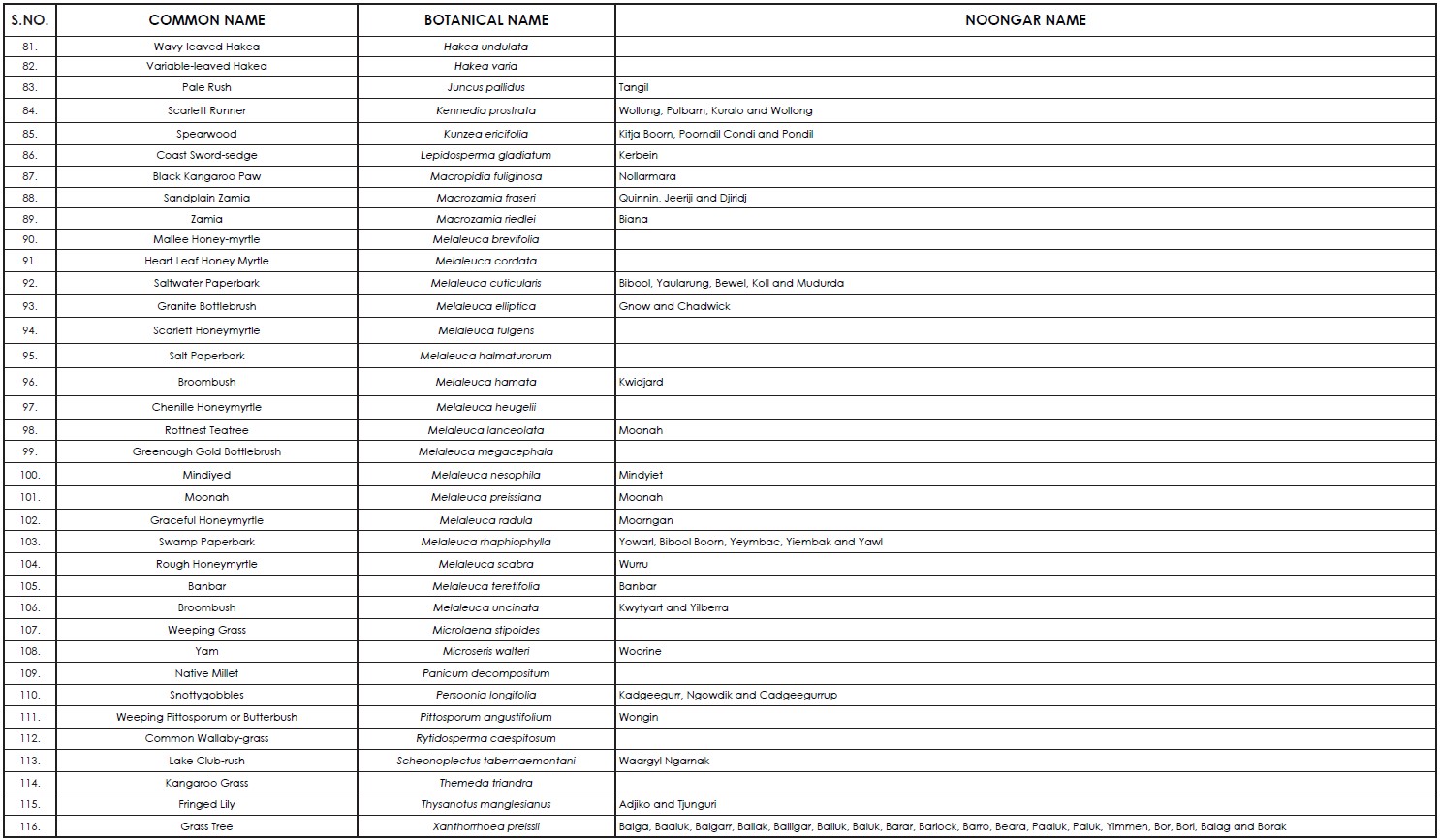
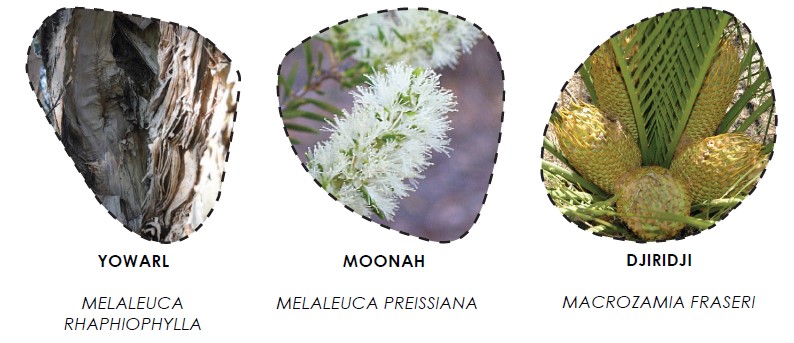
For local Noongars, the Swamp Paperbark is probably one of the most significant plant species in the region. The bark of this melaleuca is thin and papery and can be used for a variety of purposes. Long strips of the bark for example, can be used as roofing for mia-mias (shelters) and smaller pieces can be used to carry water or to hold food. Melaleuca bark is frequently used in Noongar cooking. Meat dishes, such as kweeyar (frogs), djildjit (fish) or yonga (kangaroo), are often wrapped in the bark of the Yowarl before being placed on hot coals or in an earth oven.
The leaves of the Moonah were used to relieve congestion and to treat aches and pains.
The Djiridji produce large seed pods which look somewhat like green pineapples. These pods are home to a number of orange bayu which contain significant levels of toxins. Some Aboriginal people consider bayu a delicacy and different Aboriginal groups around Australia undertake various preparatory processes before eating them. In southwestern Australia the bayu are sometimes collected in a reed bag which is then soaked in running water for a period of time to leach out the toxins. The seeds are then buried underground, often for 6 months or more. After this time, Noongar people peel the seeds and eat only the orange skin. Elsewhere in Australia, it is the seeds themselves that are eaten, and these are often crushed into a porridge-like meal and then formed into cakes and roasted in ashes. Some Aboriginal groups soak the seeds in water for an extended period of time and many do not bury them.
“WE AT URBAQUA RESPECTFULLY ACKNOWLEDGE THE TRADITIONAL OWNERS OF THIS LAND AND WE PAY OUR RESPECTS TO THE ELDERS PAST, PRESENT AND EMERGING.”
REFERENCE
- ABORIGINAL PLANT USE IN SOUTH-EASTERN AUSTRALIA, AUSTRALIAN GOVERNMENT, AUSTRALIAN NATIONAL BOTANICAL GARDENS
- FRIENDS OF QUEENS PARK BUSHLAND
- KAARTDIJIN NOONGAR KNOWLEDGE
- KINGS PARK & BOTANICAL GARDEN
- GOVERNMENT OF WESTERN AUSTRALIA
Disclaimer: The information in this booklet is not intended to be used to diagnose, treat, cure or prevent any disease or for any other therapeutic purpose. We do not accept any liability for any injury, loss or damage caused by any use of information provided in this booklet. Links to external resources are provided for the reader’s convenience only and should not be considered an endorsement of any third party product, service or information.
